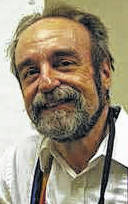
In some ways, Easter is a strange holiday. For one thing, its date bounces around the calendar. Small children search for eggs and worship a large rodent. This year, the highest holiday of the Christian calendar is followed the next day by the less reputable April Fool’s Day.
You can blame those Easter oddities on the moon and the vernal, or spring, equinox.
The date of Easter hearkens back to the Jewish Passover celebration. Both are celebrations of spring — when the world is reborn in a flurry of new life.
They are both connected with the moon, which grows and then shrinks over a month. The moon disappears for one day each month and then is reborn as a thin crescent.
In cultures worldwide, the moon’s death and rebirth symbolize the death and rebirth necessary if we and the planet we live on are to be renewed. Christians celebrate the death and Resurrection of Jesus during the springtime season of rebirth and with an eye on the moon’s cycle of phases.
Our Roman calendar is based on the sun’s apparent motion around the sky, while the Jewish calendar is based on the moon’s phases.
The number of lunar cycles does not divide evenly into the solar year, so the Passover celebration begins on a different day each year.
Passover begins on the evening of the first full moon after the vernal equinox, the first day of spring.
During the early days of Christianity, the date of the Easter celebration was not fixed. Constantine, the Christian Emperor of Rome, convened the Council of Nicaea in 325 CE to settle the matter. The council decreed that Easter would happen every year on the Sunday following the first full moon after the vernal equinox.
If the full moon happened on a Sunday, then Easter would be celebrated on the following Sunday. The council also ruled that Easter had to occur after the beginning of Passover.
Roman Catholic and Protestant churches eventually abandoned the Passover rule. The eastern churches did not, so the Eastern Orthodox Church sometimes doesn’t celebrate Easter on the same Sunday as other Christian churches.
Easter Sunday is followed the next day by one of our strangest holidays this year. April 1 is traditionally April Fool’s Day.
Again, the Romans and their calendar must get some credit and blame. Near the end of March, the Romans celebrated Hilaria, a festival honoring the resurrection of the god Attis. They also began their year around the same time, which happens to be on or near the spring equinox.
Hilaria was thus a spring celebration, a time of revelry when practical jokes abounded.
Over time, the practices of Hilaria were stripped of their mythological significance, but the practical jokes remained.
The old Roman calendar, initiated by Julius Caesar in 46 BCE, was so flawed that by the 16th century, the solstice had migrated well into April.
To fix the calendar issues, Pope Gregory reformed it in 1582. One of his alterations was to move the beginning of the year from around the spring equinox to January 1.
Old habits die hard. In France, some folks clung to the old notion that the new year began as the world was resurrected from the depths of winter in April.
The practitioners of the new Gregorian calendar made the traditionalists the butt of jokes, notably by calling them April fools. According to some historians, our modern April Fool’s Day was born.
The moon also figures into the Anglo-American habit of celebrating Easter by distributing eggs to children.
When the early Catholic Church began to spread its religious beliefs in England, they realized they could make their religion more palatable by incorporating some of the harmless practices of the indigenous religions.
In those days, the English worshiped many gods. Among them was Ostara – Eostre to the Romans — the goddess of springtime. She brought warm weather and made the world burst forth with new life.
Near the first day of spring, when her powers were at their greatest, Eostre gathered little children around her and performed feats of magic. One fine spring day, as the children sat before her, a beautiful songbird landed on her outstretched finger. To the children’s delight, she transformed the bird into a rabbit.
The children squealed with delight until they saw that the rabbit was weeping. It had been a bird that could fly high above the clouds, safe from all harm. Now it was a rabbit, prey to all the animals who love to eat bunnies for breakfast.
The children begged Eostre to change the rabbit back into a bird, but that she could not do. Instead, when her powers are at their greatest on the first day of spring, she can transform the bunny back into a bird for only one day. On that day, the bird lays her eggs.
The next day, the bird must become a bunny again. However, she remembers
the children who took pity on her. On that day, she delivers her eggs to all the world’s children.
On all other days, the rabbit lives on the moon, where she may still soar high above the clouds, safe from harm. If you look at the dark markings on the full moon, you can see the outline of the rabbit to this very day.
And that is why, on the highest day of the Christian calendar, the Eostre Bunny still delivers her eggs to the descendants of the children who took pity on her so long ago.
Tom Burns is the former director of the Perkins Observatory in Delaware.

